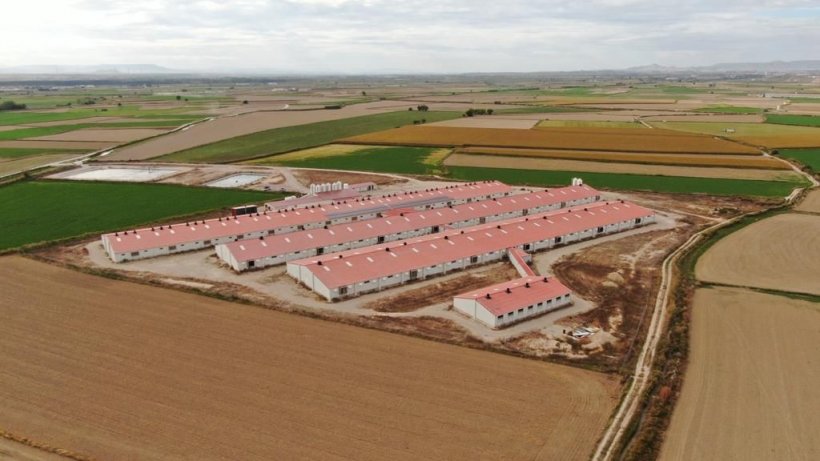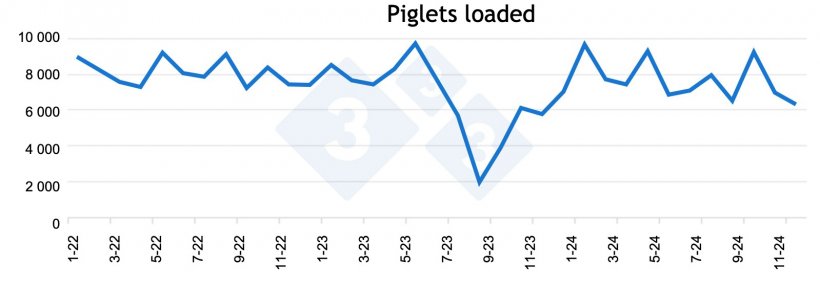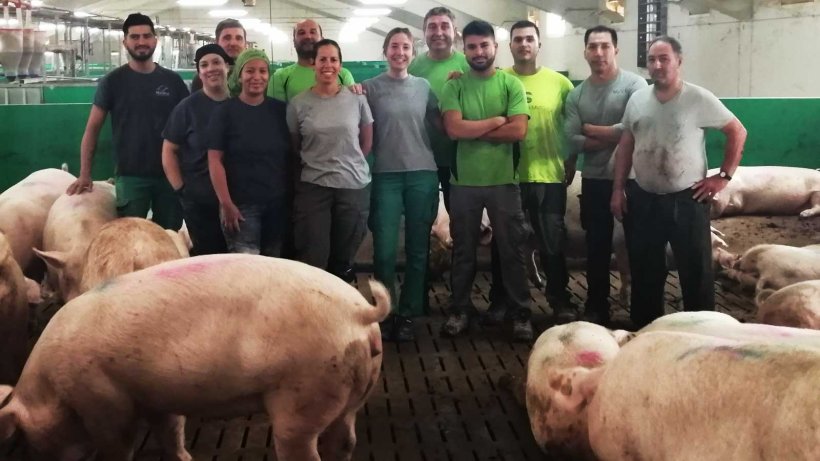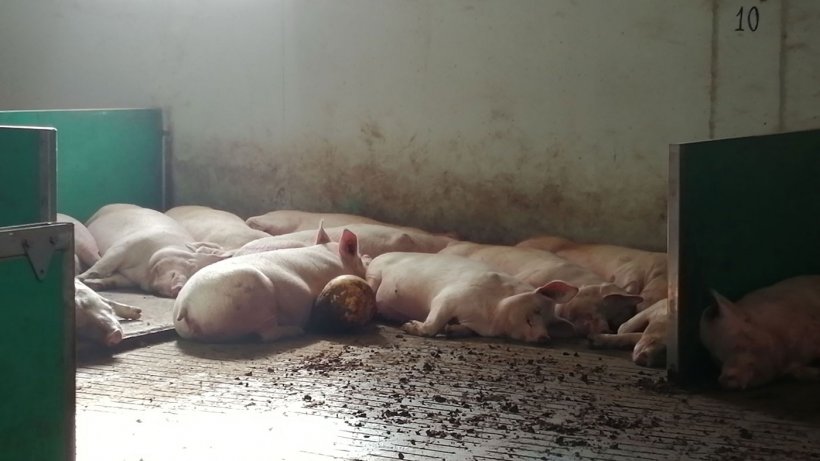Start of the problem
We will analyze a case that occurred in mid-2023 on a 3300 sow farm with weekly batch management. The farm had high biosecurity standards in place, but it is located in one of the most densely pig-producing areas of Spain, in the Cinco Villas region of Aragon.


At the time of the outbreak, the farm was PRRS positive stable, producing PRRS negative piglets, and the last outbreak had occurred five years earlier. The farm's production levels were acceptable for the average in Spain, at around 30 piglets weaned per productive sow per year.
Starting in early 2023, all nearby farms were becoming infected with the Rosalia strain, a highly pathogenic strain of PRRS, and for this reason, biosecurity measures were rigorously increased in terms of visitors, maintenance operators, loading trucks, feed services, slurry management, etc.
Despite all this, in mid-June 2023, the sows stopped eating in a gestation barn and subsequently in a farrowing unit. Within days, the clinical symptoms had exacerbated and the laboratory confirmed our suspicions by identifying the Rosalia strain of PRRS.
The outbreak caused more than 600 abortions and more than 150 sow deaths in the first two months. Piglet losses were catastrophic (Figure 1).
The impact of the Rosalia strain on the farm during the outbreak and for the remainder of 2023 was a loss of 18,000 piglets at the sow farm, not counting the high mortality in the nursery and finishing stages of the viremic piglets from this source.

Figure 1. Number of piglets loaded on the farm from January 2022 to December 2024.
There were weeks in which no piglets were loaded because mortality was very high, and the few surviving piglets did not meet the appropriate conditions for loading.
Viremia
The two months of viremia were very hard to bear. The farm employees fell into a pessimistic dynamic and our work became harder and much more thankless than usual, apart from our productivity bonuses being lost or reduced. The farm owners' incomes plummeted during those months and they had to resort to financing from banks and aid from the integrator company.

The impact of a disease outbreak on staff morale can be profound and must be considered by the management team.
High mortality overwhelmed the carcass disposal systems, which in our case was hydrolysis, so we had to resort to buying containers and working with the company in charge of carcass removal.
Recovering the structure of mating batches
The outbreak caused a drastic reduction in farrowings and weanings for several weeks, which led to the loss of the productive structure of the weekly batches and caused reproductive destabilization on the farm. It became necessary to recover the structure of the weekly batches so a series of actions and treatments were followed.
General actions and treatments:
- The mating target was increased from the previous target of 180 to 190 sows per week.
- Aborted sows with poor history, body condition, and older age were eliminated.
- The remaining aborted sows were treated with D-Cloprostenol to reduce the risk of uterine infections and facilitate the evacuation of uterine debris, often accompanied by an antibiotic as assessed by the veterinarian.
- Sows were never mated during the 10 days after abortion.
- Sows that appeared febrile and stopped eating were treated for 3 to 5 days with an anti-inflammatory/antipyretic.
The aborted sows were categorized into three types with the objective of reincorporating them into the weekly batches. Once categorized, the next action was to resort to the use of hormonal treatments in the aborted sows and in those that had had problematic farrowings to re-synchronize the batches.
Aborted in the first third of gestation: Sows up to 40 days of gestation
In this type of abortion, the sows were mated as they came into estrus if the sows were well and did not show discharge). Once a week, the aborted sows were remarked with blue spray, since they were loose in a group and the marking that facilitated their identification would wear off.
In the first batches, we tried to achieve the weekly mating objective using the females in the mating area + sows returning to heat + sows that aborted in the first third of gestation.
Aborted in second third: 40 to 70 days of gestation
A pen was reserved for the sows that aborted in their second third. The group of sows in this pen was managed as a dynamic group:
- Sows that aborted were added
- Sows were removed as they came into heat
In this grup of aborted sows, the feed ration was increased to facilitate the recovery of body condition and reduce fights. Altrenogest was also used in the sows that needed it, depending on how the mating objective was being achieved.

Sows in group gestation.
At the same time, use was made of the empty spaces from the dead sows in the farrowing room to place aborted sows and give them Altrenogest until it was time to wean the batch.
The batches from which aborted sows had been removed in the second third were completed with gilts from the quarantine.
Aborted in the last third of gestation: over 70 days.
These sows were left in their corresponding batch in late gestation and waited for this batch to reach the farrowing room to give them Altrenogest and wean them with their corresponding group.
Stabilization
Stabilization after a PRRS outbreak with the goal of producing negative piglets depends to a large extent on the management of their replacement.
The option with the best chance of success involves stopping the introduction of replacement gilts for eight months. This is a very difficult decision to make, and it was not implemented in our case. On a farm like ours, with an inventory of 3,300 sows and 48% annual replacement, cutting replacement for eight months would have meant 1,056 fewer sows on the farm and reducing the census to 2,244 sows.
The drastic decision to cut the introduction of replacement gilts during an eight-month period, which is not usually applied on many farms, should be more widely used considering the productive impact that PRRS outbreaks have in all phases of the production pyramid. To do so, the sow farm must be economically compensated.
Delaying health stability and increasing the period during which the farm produces PRRS-positive piglets generates serious losses due to the destabilization of post-weaning phases which generates very high mortalities.
So, how did we handle replacements?
The farm had an internal quarantine in a separate building attached to the farm where PRRS-negative gilts of two ages, five and six months, were received periodically.
When the Rosalia strain of PRRS entered, there were about 160 replacement gilts left in internal quarantine, and when the outbreak was confirmed, they were moved to the mating area where they got infected with the rest of the farm (week 26 -2023).
With the quarantine empty and in the middle of the outbreak, the decision was made to bring in one last batch of gilts, in week 28, of 320 slightly younger gilts than usual, in an attempt to infect them along with the rest of the farm, before attempting stabilization.
The objective was:
- Have enough time to stabilize the viral process on the farm,
- Infect and vaccinate the replacements in quarantine to ensure that when they entered the farm, they had already overcome the disease and did not provoke another recirculation.
- To monitor this process, oral fluid analysis was performed in quarantine to:
- Verify negative PRRS status at entry.
- Verify infection using PCR of oral fluids from stillborn tip tongues.
- Verify that the replacements did not excrete virus using PCR of oral fluids.
Once the PCR is negative in the quarantine, the gilts entered a specific area of the mating area.
After the entry of replacements in the internal quarantine in week 28 , with the objective of increasing the period in which there was no entry of gilts in the farm, a project was initiated to mate the gilts in an external quarantine with the purpose of bringing these mated gilts with negative PRRS status, directly into the farrowing room. .
Post viremia
After two months of viremia, we started with periodic checks in the farrowing unit with the weekly collection of tip tongues of stillborn piglets, separated by room, and specifying whether they were from primiparous or multiparous sows.
Only after obtaining negative results in all tip tongue samples for four consecutive weeks, a strict McRebel was implemented in the farrowing unit, and internal biosecurity measures were increased between barns with personnel changing clothing and footwear.
Subsequently, piglets were screened at weaning via serum analysis. If these samples were negative for five weeks, the farm was considered stable positive. At that time, at the end of November 2023, we decided to reintroduce replacement sows into the internal quarantine.
Negative gilts that had been mated in an external quarantine were also introduced.
The objective in initiating this program of mating the replacements in an outside facility was to have achieved sow farm stabilization by the time they were introduced. This goal was not achieved, and the entry of PRRS negative gilts mated externally caused another PRRS recirculation on the farm.
Unfortunately, in January 2024 we again had virus recirculation and abortions in late gestation.
More than a year after the start of the outbreak, in February 2025, the farm has not been able to reach pre-infection production levels, and PRRS positive piglets continue to appear periodically at weaning, and abortions and associated problems have not been radically curtailed.
Given the impossibility of stabilizing the farm, it has been decided to extend the farm's internal quarantine in order to be able to acclimate the sows and reduce inflows.
The biosecurity plans have been revised and some new measures have been added. Air filtration has been ruled out given the characteristics of the farm and its location. Finally, we are in the process of switching to five-week batch farrowing system to try to stabilize the farm after suffering this and possible new outbreaks of PRRS, which are very probable in an area with high swine density such as the one where the farm is located.



